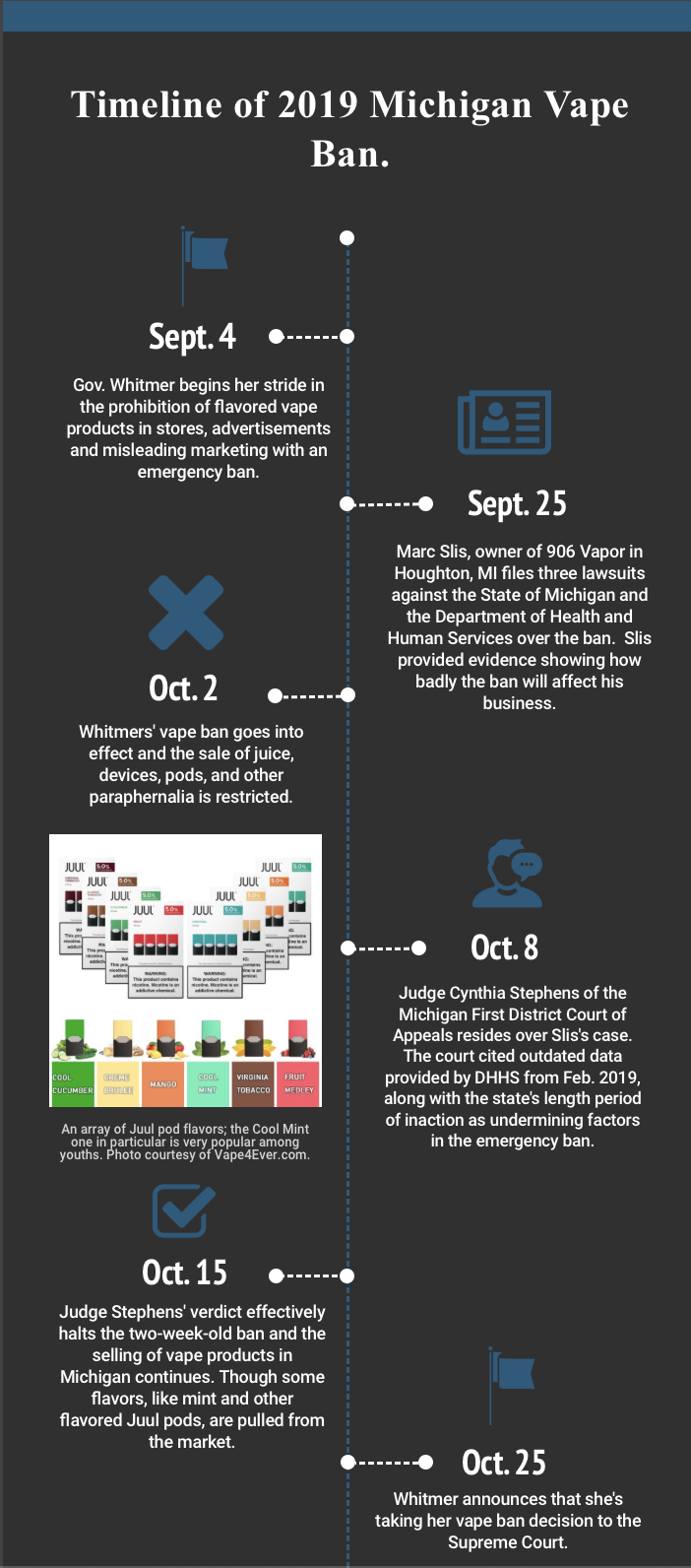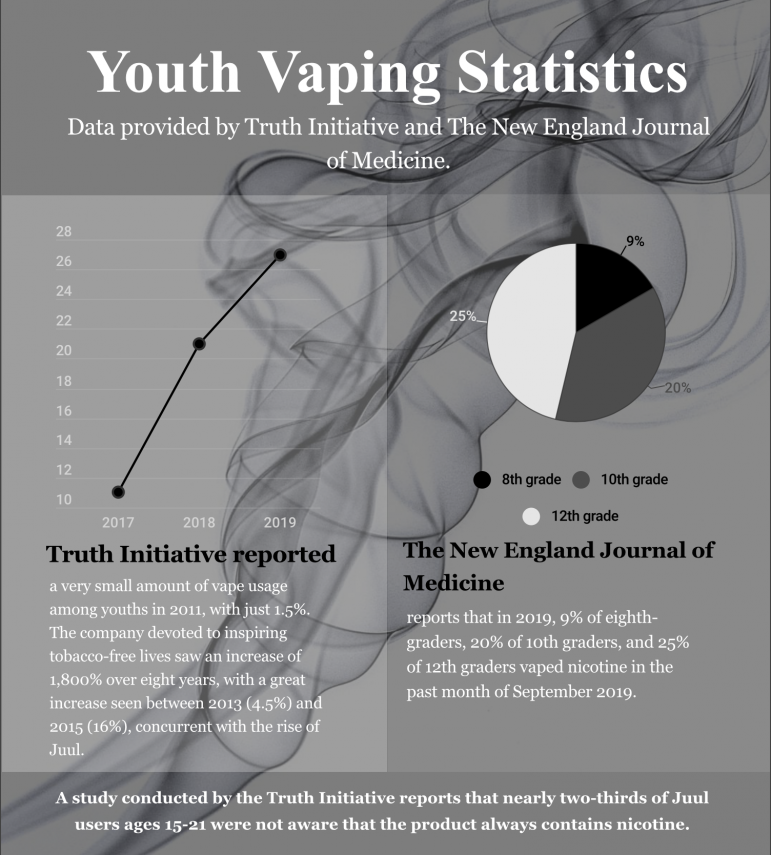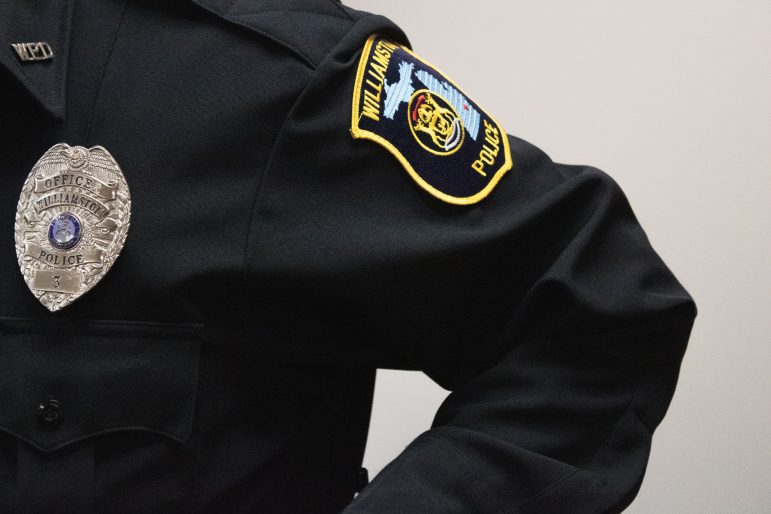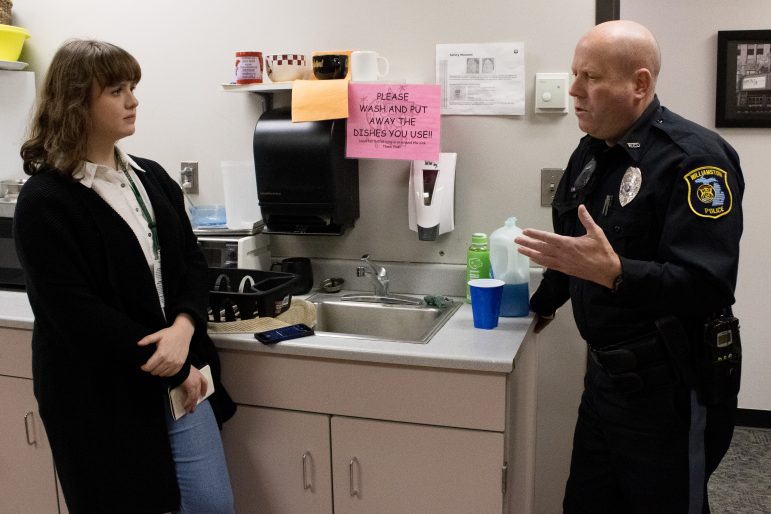Michigan made history as the first state to move toward a flavored nicotine vaping ban on Sept. 4, with other states like New York, Massachusetts and Oregon following shortly after.
With an increase in vape-related deaths being reported across the nation, Gov. Gretchen Whitmer (D) with the help of her Chief Medical Executive Dr. Joneigh Khaldun concluded that underage vaping constitutes as a public health emergency.
Under Whitmer’s orders, the Michigan Department of Health and Human Services issued rules detailing the ban, including the prohibition of flavored nicotine products in stores and online and misleading marketing strategies claiming the products are “safe.” Whitmer also ordered the Michigan Department of Transportation to outlaw vape advertisements on state billboards.

“As a governor, my No. 1 priority is keeping our kids safe,” said Whitmer in a statement on Sept. 4, “And right now, companies selling vaping products are using candy flavors to hook children on nicotine and misleading claims to promote the belief that these products are safe. That ends today.”
From Whitmer to Williamston
Roughly 20 miles east of the Michigan State Capitol is Williamston High School, home of the Hornets and about 600 students. In October, Principal Steven Delp sent out a detailed statement regarding the effects of underage vaping to parents. In this, Delp cited 15 articles and included pictures of common vaping devices in an effort to decrease the usage in the school and to protect the health and wellness of the students.

“Students are under the impression that vaping isn’t going to harm them,” said Delp. “Articles have started to come out within the last couple months with truly how damaging vaping can be on the lungs. So I think there’s a false perception that it isn’t going to hurt them and I think it’s a trendy thing to do, especially with the flavored vape juice. It’s seen as the cool thing to do among students.”
Taking a drag is taking a toll

Linda Ereg, a counselor at WHS, has had students come into her “Wizard of Oz” themed office to voice their fears regarding their struggle with nicotine.
“None of the kids tie academics or their physical well being to vaping, because when you’re young, you think you have forever,” said Ereg. “You don’t tie anything like that together. I feel bad. Why vaping? Who thought of that?”
A substance abuse therapist for two years prior to her employment at the high school, Ereg knows the warning signs of a budding addiction.
“When you take that risk to have it on your person, that’s addiction,” she said. “There have been kids who have said, ‘You don’t get it. When I’m in school, I’m losing my senses thinking how I’m going to get out of this building with no nicotine.’ There was another kid who actually said, ‘I don’t see the problem here.’”
Teen usage statistics since 2017.
Data provided by Monitoring the Future Institute for Social Research, a University of Michigan conducted study, was posted to the New England Journal of Medicine on Sept. 18. In this, new data collected in 2019 showed that one in four students in the 12th grade vape nicotine; with one in five juniors, and one in 11 eighth graders using as well. These numbers are almost double what U of M scientists surveyed two years prior.

In a Newsweek article published Oct. 1, Richard Miech, a U of M professor and principal investigator of MTF reiterates how little the public actually knows about the effects of vaping,
“Much remains unknown,” Miech told Newsweek. “Keep in mind that it took decades to build up a substantial body of good research on cigarette smoking. People who vape today are basically volunteering as guinea pigs.”
The director of the Center for Disease Control, Dr. Robert R. Redfield released a statement in September that highlighted just how dangerous vaping underage can be to the youth of America.
“Nicotine can harm the developing adolescent brain,” said Redfield. “We must do everything we can to reduce the use of e-cigarettes among middle and high school students to protect them from immediate lung injury and a lifetime of nicotine addiction.
Williamston Police Department’s involvement
WHS is regularly monitored by a police liaison with Williamston police officer, Don Smith.

“He’s not assigned to the building full-time but he’s in the district regularly and he rotates between here and the other buildings, so police have a regular presence in our school,” said Delp.
Smith is an expert when it comes to catching kids with nicotine paraphernalia, and he dedicates much of his work and time to keep Williamston students safe and away from nicotine products.

“When I pull over a student, before you even approach the vehicle, you can tell if the student vapes in that car,” said Smith. “When you vape in your car, it leaves a film on the windshield. You can see a haze on the window and immediately know if that person had been vaping. If it’s doing that to your car windows, imagine what it’s doing to the inside of your lungs. So, this whole thing that they’re not bad for you, well, they are bad for you.”
Vape education within WHS
The decrease in popularity of vapes and e-cigarettes in WHS could even be credited to the supportive staff and teachers who encourage a nicotine-free lifestyle and offer knowledgeable helping hands for students who may need it.
“We have a roadmap to success assembly the second day of school were we cover a variety of ways to be successful throughout the school year,” said Delp. “When we get to some student behavior issues we talk extensively about vaping.
“In health class we talk about vaping and the addictive qualities of nicotine,” said Adelle Banister, the health and physical education teacher at WHS. “We talk about how it affects the brain, how it changes the brain, how neurotransmitters work and how they’re affected. Then we get into long-term effects. Vaping is linked to a higher risk of pneumonia and a higher risk for other illnesses, and I think this has lessened use among students.”
WHS teachers and administrators have fed students necessary media coverage, school assemblies, in-class lectures on the vaping epidemic. Students are also receiving advice from teachers, parents and administrators, and fair punishments when caught. Though vaping has been on a noticeable downhill, vaping hasn’t completely stopped. Students who need their fix have learned to be more discrete at hiding their paraphernalia.
“There’s no doubt it’s happening here,” said Delp. “I’m not naive. I think kids have just gotten smarter about it.”

“I think it’s become quite an epidemic,” said Ereg. “It’s everywhere. For a minute, students were getting caught because they were acting too bold and not hiding their vapes. It was insane. But recently students aren’t being as flamboyant with it.
“I know, a lot of the time, students vape in bathrooms on campus or in their cars right when they leave school,” said Robbie Harbert, WHS Fitness Center Lead. “I know a lot of them are doing it.”
Noticing a decline
Delp said he thinks vaping among students has become less common this school year compared to last.

“Kids aren’t as blatant about it because they’ve realized we’re onto them, all the schools are onto them, and it’s something that all schools are cracking down on,” said Delp.
This could be because of Whitmers’ ban or because of the punishment WHS has instituted to those caught with a device on campus; a two-day suspension.
“The kids know that vaping is harmful,” said Dale Williams, a personal trainer and assistant track and field coach at WHS. “We need to keep showing them that it has negative consequences.”
Expectations for the future
WHS teachers, administrators, and other school district officials are taking the necessary steps in order to show students the dangerous repercussions of vaping, as well as the benefits of living a nicotine-free life. Regardless of the reason for the decline in WHS, vaping on the national level, due to a plethora of articles published bringing attention to the risks, has been on a downhill, and that’s a successful start.
As Whitmer’s ban heads to the Supreme Court, communities will learn more about the future of vaping within WHS and other schools statewide.
“I think Whitmer’s ban is a good thing,” said Delp. “I think between the ban and us trying to get the word out there to students that this potentially is having significant negative physical impacts, hopefully we can deter students from vaping.”